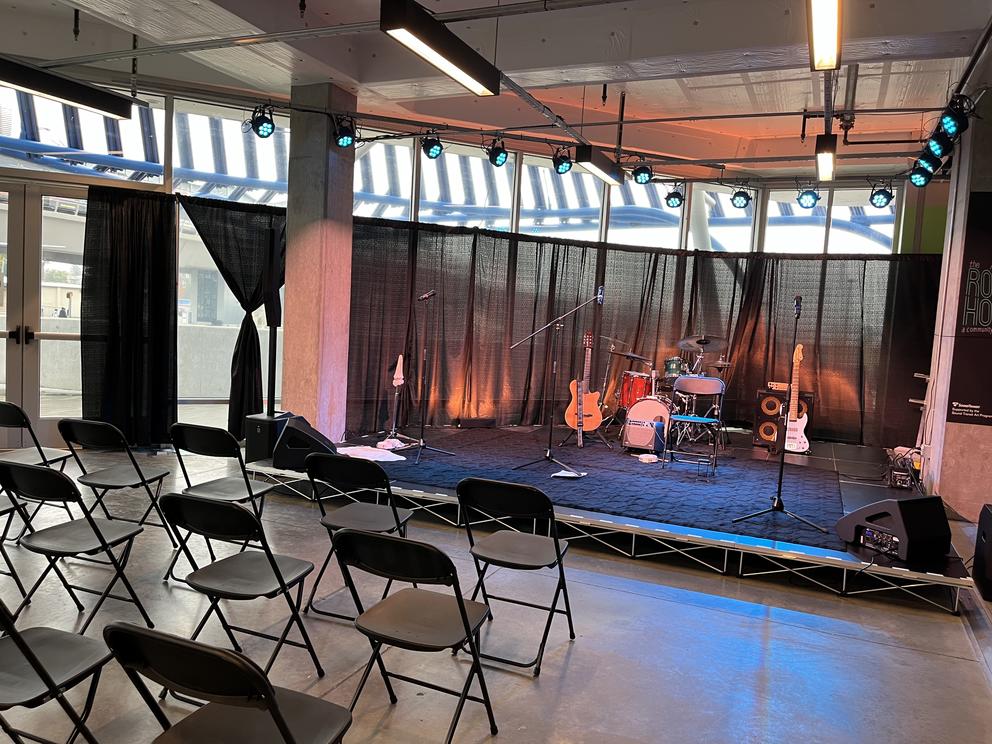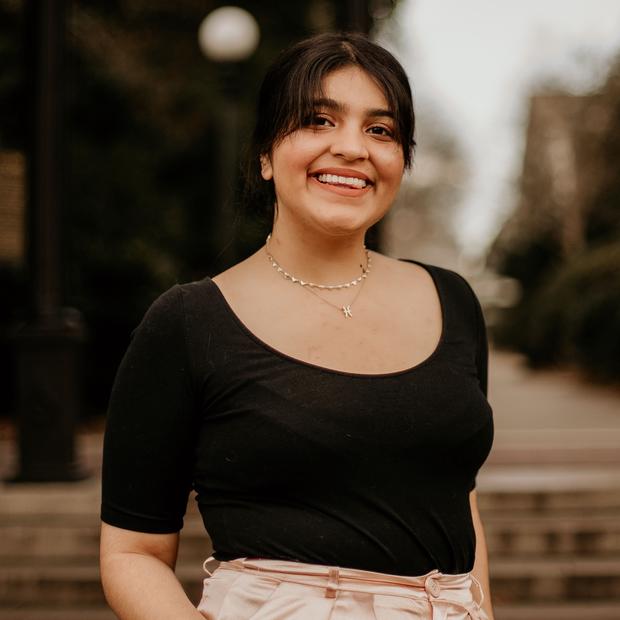And soon its rail users will also hear guitar strums, drumbeats and vocal flourishes coming from a new, intimate performance space, The Roadhouse.
Set to open October 29, The Roadhouse is an all-ages live music venue headquartered at the Angle Lake light-rail station in SeaTac. Look for it near the parking garage, under a forthcoming neon sign. In addition to producing music shows, the venue (occupancy 145) will be rentable for special events, rehearsals, workshops and classes.
This pilot program is part of STart, Sound Transit’s public art program (funded by 1% of construction budgets).
It will be managed by musician and arts educator Eduardo Mendonça, owner of Show Brazil Productions, an educational arts organization based in Kent, where Mendonça lives. After one year, stakeholders will determine whether The Roadhouse experiment is successful and worth continuing.
“The Roadhouse will fill a gap of opportunities,” said Mendonça, who has performed guitar and percussion for luminaries from Nelson Mandela to former Brazilian president João Baptista Figueiredo.
“People need to go to Seattle to do things that are related to music and culture,” he said about venue options in South King County. “We do have events and opportunities that happen in South King County, but The Roadhouse for sure will be a very good addition in a different way to having our community here.”
To that end, Mendonça is aiming to make The Roadhouse as inclusive as possible. In addition to a welcoming spirit toward communities of different cultures and backgrounds, both as performers and audiences, The Roadhouse will be open to the under-21 crowd.
Taking a cue from Jimi Hendrix
Since 1998, STart has worked with national and local artists to create large-scale artworks to elevate the Sound Transit system.
A few notable works include Ellen Forney’s 2015 murals Crossed Pinkies and Walking Fingers at the Capitol Hill light-rail station; Leo Berk’s immersive electric-blue artwork Subterranium at the University of Washington station and Barbara Earl Thomas’ glass and metal images at the forthcoming Judkins Park station.
But until now, all the STart projects have been stationary works of visual art — not performance venues.
The Roadhouse’s beginnings trace back to Seattle installation artist Sarah Kavage, who in 2017 was named the STart artist-in-residence for the Federal Way light-rail extension.
Kavage isn’t from South King County — she lives in Seattle. So she, along with The Roadhouse’s feasibility consultant Darryl Crews (hired by Sound Transit), started conversations with residents about the area’s cultural connections. What they found was a rich music legacy.
“It had its own history of having clubs and music venues, roadhouses, dance halls, all through here,” Kavage said. “As I understand it, that was something that really got going during the Prohibition era, when South King County was out of the reach of the cops — Seattle cops and Tacoma cops.”
The most famous roadhouse in South King County was the Spanish Castle Ballroom in Des Moines, where teenaged Jimi Hendrix used to hang around and ask performers if he could join them onstage, long before he became an international superstar. He penned his song “Spanish Castle Magic” after the venue.
Kavage and Crews also found that residents felt community gathering spots were lacking, especially live music venues, and especially for young people.
This local feedback — along with Sound Transit’s decision not to bring a retail business into the Angle Lake space, as originally planned — opened the possibility of creating a performance space for local artists and music lovers.
“We’re hearing that there’s a need for space like this ... it’s going to be a big experiment to see who’s interested and what might come from it,” said STart deputy director Barbara Luecke.
And while the name suggests a dark bar with beat-up stools, The Roadhouse radiates brightness with a facade of floor-to-ceiling windows.
Inside, an array of fake leafy ficuses brings the outdoors in. The walls “backstage” — an area sectioned off with curtains — boast fresh coats of lime-green paint. The majority of the translucent drapes on the windows are sheer black, but a few are adorned with tropical leaf patterns. Cozy black couches in the audience section sit on a green carpet.
“The green is very intentional,” Kavage said. “In these conversations with folks … who are new immigrants to the area, so many people mentioned the nature of [Washington].” Green happens to be a personal favorite of hers too. “It is very calming, and yet it has some nice energy to it,” she said.
On one wall, Seattle-based artist Juliana Kang Robinson painted a mural of nested arches in varying hues of blue surrounded by bursts of pink and yellow, with a center of bold metallic gold. The effect is a virtual doorway — a visual welcome into the space.
Light rail as a connector of all kinds
In the past, STart’s work has traditionally focused on beautifying transit stations through visual artworks that reflect the region’s history, environment and populations. “When we hire artists, we’re tasking them to create artwork that is specific to a place and meaningful to a community,” said STart senior project manager Ashley Long.
The Roadhouse is working toward the same goals, but via live music.
“I have not seen a transportation organization like Sound Transit invest heavily in a cultural space,” Mendonça said. “I think we are a pioneer.”
Mendonça, who’ll serve as production manager for The Roadhouse, says he can already envision commuters stopping by the venue as they’re getting off the light rail — drawn by the sound of music through the windows or peeking at performances through the open curtains — and joining the fun.
“Every time that you go there, we are hoping to have something different, something that can be unique, and something that can support people in their individuality to express their music,” Mendonça said.
Transit is a connector — of physical places, but also of people and ideas, Kavage and Crews both noted. With that in mind, The Roadhouse also aims to be a connector, of people from different backgrounds, cultures and ages in the diverse area. In South King County, approximately 20% of residents are under 18, 10%-20% are Black or African American and 16%-21% are Hispanic or Latino.
The Roadhouse augments a short list of local all-ages music venues, including The Vera Project (since 2001) at Seattle Center and Black Lodge (which reopened earlier this month in South Lake Union after closing in 2020).
In South King County, the options are almost nonexistent; most places where people of all ages can hear live music are restaurants. Other small performance venues are open only to people 21 and older.
In addition to creating a gathering space for youth, Crews said The Roadhouse has an added benefit: offering young artists a space to hone their musical craft.
In the coming months, project leaders at the venue will work with students and teachers to further music education. The Roadhouse already has a working relationship with Highline College’s diversity department in Des Moines.
Mendonça added that The Roadhouse will have opportunities for students to get hands-on experience working on shows, whether through performance production or general event support. The intention is to expand the educational reach to K-12 students in the area as well, but those partnerships are still in development.
“How are we supposed to generate the next generation of artists if they don't have a place where they can showcase their work, or develop?” Crews said. “The idea that young people can be here and witness the work, young people can perform in the space — it’s just like [how] everyone can ride transit too … transit is for everyone, and this is an extension of transit.”
The sounds of The Roadhouse
The grand opening on Oct. 29 will include three live performances, one by 20-year-old Seiha Bunkasem, a member of The Roadhouse’s community advisory board and curator of the venue’s social media presence. He’s excited for a new music space, saying that South King County lacks options for younger people to experience live music.
“I think community centers and places where kids can come to [be] themselves have kind of diminished,” Bunkasem said. “I feel like in South King County we need more.”
At the opening, he’ll be performing his faith-based rap and R&B music. Another musician, 25-year-old Seattleite Adobee Brino, will play an acoustic set, and Seattle-based Polynesian dance troupe Huraiti Mana will perform.
Mendonça said his production company — which commonly performs Brazilian music and offers educational workshops — is planning approximately 20 events in the space over the next year, all free to the public.
Those include a series called “The Sounds of Roadhouse,” aimed at both adults and teens and featuring performances by local artists of various genres — anything from indie to pop to Latin music. Another called “Who Is in the Station?” will bring in community organizations to host their own events and increase their visibility.
In addition to those quarterly events, Mendonca notes that the space will also feature performances by groups that rent it.
The Roadhouse will have one year to make its case as a necessary and frequented venue. According to STart’s Long, success will be measured by metrics such as attendance at STart-programmed events and general community interest. At the end of next year, STart, Mendonça and the community advisory board will decide what the future holds for The Roadhouse.
Certainly the arrival of the venue is good news, with the live music industry still emerging from the financial turbulence caused by COVID-19 closures.
And if it succeeds, perhaps another young Hendrix will find themself hanging around the stage on the way to superstardom.
Get the latest in local arts and culture
This weekly newsletter brings arts news and cultural events straight to your inbox.






